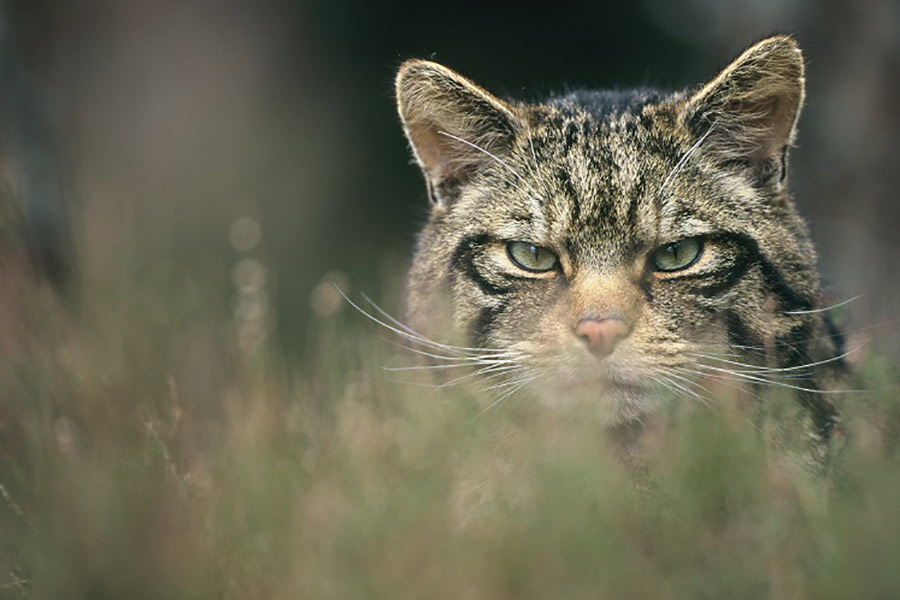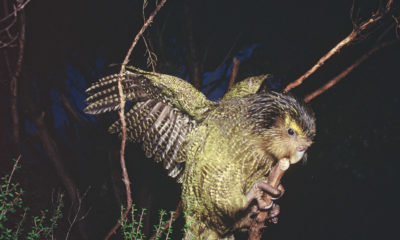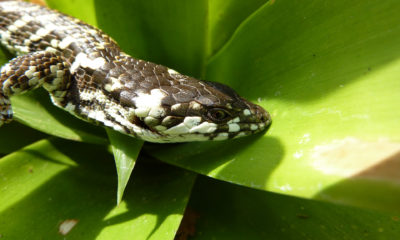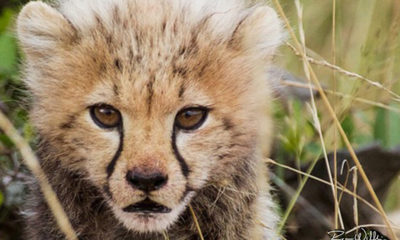Conservation
Scottish Wildcat
Working its way through a fresh layer of snow, tail whipping back and forth with nose following a rabbit’s scent, this instinctive hunter patiently tracks a victim. Here in the Scottish Highlands, winter has arrived, and hunger is driving the cat through the cold.
Published
6 years agoon

- The Scottish wildcat is predicted by some conservation groups as being at risk of extinction within five years
- Scottish wildcats are thought to number, at most, about 300. Arguments exist, however, that this figure could actually be as low as 35
- A ‘taskforce’ comprised of around 20 groups was set up to oversee conservation projects in order to save this species from an inevitable extinction. Its name: Scottish Wildcat Action.
About the Scottish Wildcat
Despite the Wildcat being listed by the IUCN as of ‘Least Concern’, the Scottish wildcat (Felis silvestris grampia*) is predicted by some conservation groups as being at risk of extinction within the next five years. This disparity of assessment comes from the fact that the Wildcat as a species in Europe (and indeed the world) is relatively widespread, but it is the continual interbreeding of individuals with feral and domestic cats – known as introgressive hybridisation – that is wiping out populations. This is of particular concern for the Scottish subspecies.
According to the IUCN’s report, this subspecies – more so than any other – is heavily impacted by this issue. Whilst the rest of Europe may see around a third of their wildcats interbreed, recent studies suggest that in Scotland, that figure is as high as 88% (Kitchener et al. 2005). And whilst numbers of feral cats are probably around the 1.2 million mark across the UK, true Scottish wildcats (both genetically and morphologically) are thought to number, at most, about 300. Arguments exist, however, that this figure could actually be as low as 35.
The Scottish wildcat is vanishing before our eyes, and the impact of this is not purely ecological. This animal has played a part in Scottish folklore for centuries, being commonly referred to as the Tiger of the North and taking a place of pride on numerous family crests. Still, it is some task for all but the trained eye to tell it apart from a feral cat, particularly with there being real disagreement about how many individuals of pure-Scottish wildcat genes actually remain.
The Details
Whilst not as big as those cats in the Panthera genus, the Scottish wildcat can still reach weights of up to 8kg in adulthood, and can stretch from head to tail up to 98cm. There are some obvious visual clues when attempting to differentiate these cats from ferals aside from their size: a thick tail with a blunt tip and black stripes, a more angular jaw and a shorter gut. However, that’s dependent on you even seeing one.
Partly because of their low numbers, and partly because of their shy nature, Scottish wildcats are notoriously difficult to spot. They are active most in winter – that’s when their hunger is at a peak, requiring more time be spent hunting. It’s also when males will be searching for females in their territory with which to mate. They’re so elusive that many locals in the Scottish Highlands never see one.
Aiding both reclusiveness and hunting is a number of bodily adaptations: they have amazing senses of smell, sight and sound and, as with all cats, sensitive whiskers allow detection of minute movements. All of these enable them to eat a broad range of foods, ranging from rabbits (their main prey) to birds. Popular on the list if rabbits aren’t available are mice, voles and reptiles. They’re also happy to scavenge off roadkills when needed or available.
As is the case for many cats, this species is generally solitary aside from breeding season. At this time of year (January through to March), males will wander into females’ territories with the aim of finding a mate. If successful, they’ll leave again immediately after, with the kittens emerging a little over a month later and remaining with the mother for up to six months – despite being capable of hunting within half that period. If the litter is successful (typically with two to four kittens) the cats won’t breed again until next year.
After their first year, female cats will be ready to breed, though males may be ready from the age of nine months, and although it is thought that the species can live up to 15 years in captivity, their life expectancy is a far lower two-to-eight years in the wild. Mortality rate for kittens is also high.
So far as specific areas are concerned, the newly established lead body for Scottish wildcat conservation, Scottish Wildcat Action, has identified six ‘priority areas’: Angus Glens, Morvern, Northern Strathspey, Strathbogie, Strathpeffer and Strathavon. For individual cats, it’s hard to pinpoint the normal size of a territory: males usually have a range overlapping that of several females, but size can vary from one square kilometre up to 25. Riparian forests and new plantations are popular habitats, as they house small mammals that the cat likes to prey upon, but areas of forest with dense underbrush are also suitable, particularly for females sheltering young.
Scottish Wildcat Conservation
In order to save this species from an inevitable extinction, a ‘taskforce’ comprised of Scottish Natural Heritage, Royal Zoological Society of Scotland, the Scottish Wildlife Trust and more than a dozen other groups was set up to oversee conservation action. Its name: Scottish Wildcat Action. Other notable organisations involved are National Museums Scotland, The Royal (Dick) School of Veterinary Studies, Cairngorms National Park Authority, National Trust for Scotland, Forestry Commission Scotland and Scottish Gamekeepers Association.
This collaboration of professionals throughout the scientific, environmental and conservation fields has the possibility of being a game-changer for the Scottish wildcat. There are a number of steps involved with the work, including a Trap, Neuter, Vaccinate and Release (TNVR) program, and plans to breed cats for later release. The group was founded in 2013 but got going last year, and their Action Plan lists six key targets they are pursuing closure of within six years, which we look at below.
Conjour spoke to Eileen Stuart, Chair of the Scottish Wildcat Action Steering Group, for more insight into the organisation’s work.
“Scottish Wildcat Action is underpinned by a broad partnership which includes leading experts on wildcat conservation as well as a wide range of conservation organisations and Government agencies,” says Stuart, adding that it is seen as one of the group’s strengths. “It provides the project with a strong cross-section of interest groups and allows us to have robust discussions on both the science and practical aspects of wildcat conservation.
“This is extremely valuable in tackling the conservation of a species with such challenging conservation needs. We are extremely fortunate to have such a broad partnership. There will obviously be some differences of opinion, but what has made the partnership work is that everyone is keen to ensure the survival of the Scottish wildcat and committed to work together to achieve this.”
Counting the Cat
One of the issues with the conservation of this elusive species is that very trait: their elusiveness. But Stuart expands on the factors that come into play when trying to give a number to remaining populations, which if you go by what’s printed could be anywhere from 35 to 400.
“Wildcats are difficult to survey: they are secretive, often moving around under cover of vegetation at night and they are well camouflaged. The fact that they are also able to hybridise with the domestic cat doesn’t help us either as it’s not always obvious whether what you see is a wildcat or a hybrid.” Here, Stuart highlights that a hybrid denotes a cat with mixed ancestry, both domestic cat and wildcat.
“However,” she adds, “remote monitoring using motion-sensitive trail cameras has really helped us. The most recent survey that covered the whole range of the Scottish wildcat was conducted by Dr Kerry Kilshaw and colleagues at the University of Oxford and involved intensive use of these cameras. The study estimated a total population of 115-314 individuals.”
Considering that some reports guess at a population size of just a few dozen, this sounds fairly – relatively – reassuring. But Stuart makes a telling comparison, saying that pet cats in the UK number over 7 million (PFMA Pet Population Report) and 100,000 of these are believed to be feral domestic cats living in Scotland (according to welfare charity Cats Protection).
“These [ferals] are domestic cats that are born in the wild because their ancestors were unneutered, stray or abandoned cats,” says Stuart.
Confirming the work under way, she says that SWA has recently completed the biggest Scottish wildcat survey ever conducted.
“This involved monitoring nearly 350 trail cameras across 620 square miles of habitat in five of our wildcat priority areas,” explains Stuart, naming the spots as Strathpeffer, Strathbogie, Strathavon, Northern Strathspey and the Angus Glens. “We are now analysing the results to give us a population density estimate, but initial findings have been both exciting and very worrying: we found 19 possible wildcats, compared with 44 hybrids and 40 domestic cats, most of which were obviously feral and living wild.”
It’s clear that Scottish wildcats are facing a very real threat of extinction, heading the way of countless species before them, and that the surveying being done is only giving us more specific data to confirm pre-existing hypotheses.
“Whatever results you look at,” continues Stuart, “it is clear that there are very few Scottish wildcats left in the wild but a lot of domestic cats, including feral cats and obvious hybrids. Wildcats are now so outnumbered that it is difficult for them to find other wildcats to breed with. The fact that wildcats can breed with domestic cats and produce fertile offspring is probably the single biggest challenge to the species and to us as a conservation project. We need a major behavioural shift in the way we look after wildcats, feral cats and pet cats in Scotland and this requires a robust collaborative effort that unites people at every level to save the species.”
Without this (collaborative effort), it is clear the Scottish wildcat will be extinct within a few years.
SWA’s Action Plan – Six Targets, Six Years
The first step in SWA’s action plan is identifying and protecting wildcat priority areas. Now up for protection are the following: Morvern, Strathpeffer, Strathavon, Strathbogie, Angus Glens and Northern Strathspey. The second step, in line with the protection of these areas, is reducing threats to wildcats in the form of feral domestic cats. This will be done through a Trap, Neuter (Vaccinate) and Release programme (TNVR).
Detailing the progress of this part of the plan, Stuart says it’s just getting started.
“Winter is the best time to conduct this work because the cats are hungrier and looking for mates, so [are] more likely to wander and be interested in the bait we put out. We expect to get a lot of TNVR done over this coming winter and we’ll be making use of the intelligence from our survey as well as public sightings to do so.”
Cleverly, the negative impact of ‘untreated’ feral cats is avoided by releasing the ‘treated’ cats back to the wild.
“An obvious result of TNVR compared with lethal methods is that neutered feral cats are still living in areas with wildcats and may be competing with them for space and food. On the other hand, if feral cats were removed from the area, new feral cats (which outnumber wildcats 5 to 1 in our areas and 8 to 1 outside our areas) will move in from outside, bringing with them disease and getting into fights with wildcats as they establish territories,” explains Stuart.
“Scratches,” she says, “and bites from these fights are likely a major source of disease transmission and we want to avoid that. These incomers may also be unneutered so the threat of hybridisation would continue. Conducting intensive and geographically focused TNVR, as we are doing, may therefore be more effective than lethal control in bringing down cat numbers.
Stuart notes that, in the past, there has been public disquiet over the lethal method of feral cat control and understands the issues this presents, and says that current data suggests the alternative direction SWA is taking is the right one.
“The scientific evidence on which method is most effective is mixed, but recent evidence from New Zealand suggests that conducting intensive and geographically focused TNVR, as we are doing, can be more effective than lethal control in bringing down cat numbers.”
She adds that SWA will continue to review new evidence going forward, and will be encouraging the public to help in the actions by having their pet cats neutered and vaccinated in similar style. The next two steps in the action plan involve promotion and education around the wildcats’ cause, to help engage the public in what is set to be a challenging fight to save the Tiger of the North.
The fifth step listed involves conservation breeding, which SWA points out is different than the traditional captive breeding-style project.
“The first [captive breeding] aims to breed wildcats as a refuge population, and these wildcats are on show to the public for educational purposes. Many zoos and wildlife parks are engaged in captive breeding of wildcats already. The second [conservation breeding] aims to breed them for future release into the wild, which is a whole different ball game. It requires a much more managed approach to breeding to give the wildcats the best chance of survival in the wild. It means bigger enclosures, scientific monitoring and significant cost.”
Stuart mentions that the past year and a half in particular has been a busy period for the organisation. Their lead partner, The Royal Zoological Society of Scotland, began managing the wildcat studbook (a record of breeding individuals in any species management program) and “developed a more sophisticated genetic test that would help distinguish a wildcat from a hybrid” cat.
RZSS then began using these tests on wildcats in zoos and wildlife parks across Scotland.
“They have identified 73 individuals that may be suitable for the conservation breeding for release programme,” notes Stuart. “The next step is to assess their interrelatedness and decide how many wild-caught wildcats are needed to boost the gene pool. Semen banking is also being investigated. However, it will be a while before suitable release sites can be determined as the threats are still at large.
This is why we are working in partnership with so many organisations. The task of saving this species is significant.
Releasing the Saviours
Cats are well known for their innate hunting skills – seen from a young age through what seems like innocent playtime – and it would be easy to assume this is something a species couldn’t lose. But, Stuart warns, hunting successfully in the wild, and indeed finding shelter, isn’t necessarily something that will be done naturally by cats raised in captivity.
“The RZSS-led conservation breeding programme has been inspired by the very successful Iberian Lynx breeding programme in Spain and Portugal. Off-show enclosures are designed so that kittens brought into them will learn how to hunt and find shelter, with minimal human contact. The enclosures are large with plenty of natural cover, trees and rocks. The top is open to the elements and the mesh is wide enough for small prey such as mice and birds to move freely. Before we go about releasing any animals into the wild, there will also be test releases in controlled locations where we can closely monitor individuals’ behaviour post-release,” says Stuart.
She adds that there will, naturally, be challenges along the way, but SWA remains confident thanks to including amongst their ranks some of the world’s leading experts in the field. This is part of what enables the implementation of the sixth and final part of the SWA action plan: “Collecting a lot of samples and data to analyse, such as photographs, hair and blood, so that we can vastly improve our collective understanding of Scottish wildcats, their distribution, genetics, and the extent to which hybridisation and disease has impacted on them.”
Combining Forces
A variety of aspects of this project need to fall into place to save the Scottish wildcat from extinction. Stuart says that other partners have been working on a number of things.
“Forestry Commission Scotland have been planting native woodland and trialling artificial dens to encourage wildcats, and the University of Edinburgh’s Royal (Dick) School of Veterinary Studies has carried out post mortems on 37 hybrid cats to distinguish what diseases they were carrying. This work all informs our approach moving forward. We use scientific study to inform conservation work on the ground and help us reduce the threats to wildcats.”
As well as this, she says the public is already playing an important part.
“We have received over 80 sightings from members of the public through our website and Mammal Tracker app of wildcats, hybrids and feral cats. We are also very lucky to have recruited around 140 volunteers to help us with monitoring cameras, Trap Neuter Vaccinate Return and awareness-raising events.”
To keep track of SWA’s work, you can follow them on social media: @SaveOurWildcats.
*Taxonomic Note:Some disagreement exists as to the correct reference for the Scottish wildcat. We have used this name after the following comment from SWA: “The whole taxonomy of the small cats worldwide is going through a review at the moment. One view is that the Scottish wildcat is the same subspecies as the European wildcat (Felis silvestris silvestris). Nevertheless, the Scottish wildcat has been separated from its mainland European counterparts for around 9,000 years and over that time will have locally adapted to the environmental conditions in Scotland which are wetter and cooler than elsewhere in its range. The wildcat isn’t really a cold-loving species, and the Scottish population represent the most northerly in the world. Our view is that the Scottish wildcat is distinct enough that we should be concentrating on conserving it as a unique animal.”
Captions and credits for images, from top-down:
Scottish wildcat (Felis sylvestris) in pine forest, Cairngorms National Park, Scotland – Peter Cairns/Scottish Wildcat Action
Scottish wildcat (Felis sylvestris grampia) peering around tree, Scotland – Peter Cairns/Scottish Wildcat Action
Scottish wildcat (Felis sylvestris) in pine forest (II), Cairngorms National Park, Scotland – Peter Cairns/Scottish Wildcat Action
References:
The Scottish Wildcat Action Project website
Yamaguchi, N., Kitchener, A., Driscoll, C. & Nussberger, B. 2015. Felis silvestris. The IUCN Red List of Threatened Species 2015: e.T60354712A50652361. http://dx.doi.org/10.2305/IUCN.UK.2015-2.RLTS.T60354712A50652361.en. Downloaded on 03 October 2016.
You may like

Blakiston’s Fish Owl

Kakapo

A vote to focus attention on Australia’s amazing animals, and their alarming decline

Mexican Grey Wolf

Penguin run undergoes UK sport commentary

Penguin run undergoes UK sport commentary

Seven Worlds, One Planet – Extended BBC Trailer

Thunberg: We will never forgive you

Bilbies Released Back into the Wild in 2018













You must be logged in to post a comment Login